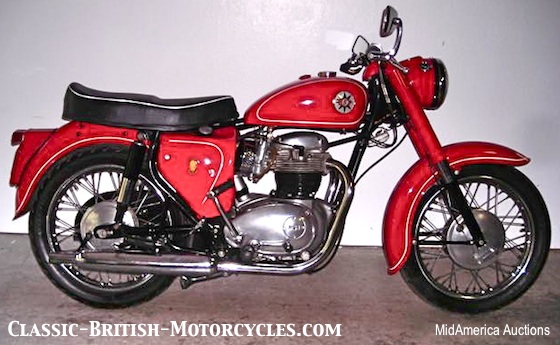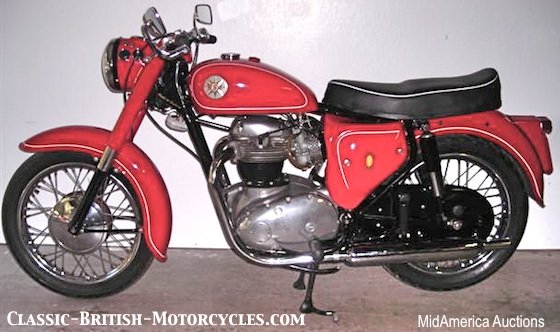1963 BSA A65
NEW MODELS
The 1963 BSA A65 was, of course, the second model year of the new unit construction BSA twins, the 500cc A50, and the 650cc A65, which had replaced the very successful pre-unit A7 (500) & A10 (650) in 1962. BSA was very conservative in the new machine’s configuration, as was their style. The 1962 BSA A65 Star was joined in 1963 by a tuned version (higher performance), the A65 Rocket. In 1965, the Rocket sprouted 2 carburetors & became the ’65 BSA A65 Lightning.
1963 BSA A65 ENGINE WORK
As would be expected from any second-year model, following such a major engine redesign, there were teething problems. It was more of a complete redesign actually, with virtually no shared components with the engine it replaced, unlike Triumph who carried the crankshaft, cams & entire top end over from pre-unit to unit in 1963. The new BSA twin really was new, and there was much to learn. Early A65s used a bushing to support the crankshaft on the timing side, and the oil that fed the crankshaft ran through it. While not as much of a problem on the underpowered 500cc A50s, it proved to be the Achilles Heel of the more powerful BSA A65. It would wear out quickly, which would starve the crank, and thus the big end bearings, for oil, ultimately leading to a catastrophic engine failure, usually in the form of a broken connecting rod or a broken crank or both. The pre-unit A7 & A10 also used a similar bushing on the timing-side main, and it too was known to be an area of weakness. So, why did BSA do it? Cost-savings, no doubt.

1963 BSA A65 & A50 VERY SIMILAR
BSA, in an another awkward attempt at saving money, built two bikes, in two different displacement classes, out of one bike. The 500cc A50 and the 650cc A65 were essentially mechanically the same in every respect with the exception of the pistons, cylinders & heads, and the front brake. The A50 had a 7-inch SLS & the A65 had an 8-incher, another crude attempt at saving money that made no sense at all. Despite the A50 being down on power, when compared to the A65, it weighed virtually the same, and needed just as much braking power to stop it, at any given speed.
NEW A65 FAILS TO LIGHT FIRES
Even by 1963 standards, the BSA A65 was looking pretty staid & conservative. This is the year Triumph introduced their exciting new line of unit-construction 650 twins & they were selling like hotcakes. But BSA‘s new unit twins failed to excite buyers. Not even as well as the pre-unit models they replaced. The market that they had been built for, the same market that BSA had built its entire business on, the cost-conscious commuter, was going away, and being replaced by people who saw motorcycling as an exciting lifestyle. The new Triumph line certainly fit the bill, and so did all these wild new Japanese bikes that had just begun flooding the marketplace. Would BSA respond, and make adjustments? Not hardly. It was business as usual, building the same bikes they always had for the same type of buyer, whether he still existed or not.
1963 BSA A65 – STEADY DEVELOPMENT
Either way, BSA continued to develop & refine its unit construction twins, and they steadily got better & better, the A65 turning into a very fine motorcycle.
1963 BSA A65 SPECIFICATIONS
|
A65 Star Twin A65 Royal Star Engine type Displacement Bore & Stroke Compression Carburetor(s) Ignition Engine output Primary drive Clutch Gearbox Ratios, overall: 1st, bottom 2nd 3rd 4th, top Final drive Frame type Wheelbase Seat height Ground clearance Suspension, front Suspension, rear Brake, front Brake, rear Tire, front Tire,rear Fuel Capacity Curb weight |
Standard Roadster Premium Roadster Air-cooled OHV vertical twin 654cc 75mm X 74mm 9.0:1 Amal Monobloc, 1-1/8″ Breakers & coils, Lucas 38 bhp @ 5800 rpm Triplex chain Multi-plate, wet 4-speed constant-mesh, right-foot shift — 11.1:1 7.18:1 5.13:1 4.35:1 Chain Welded & brazed lug, full double cradle 54″ 33″ 7″ Telescopic fork, hydraulic damping Swing arm, 2 Girling dampers 8″SLS drum 7″ SLS drum 3.25″ X 18″ Dunlop 3.50″ X 18″ Dunlop 2.4 gal (US models); 4.8 gal (UK & export) 406 lbs |



No Comment